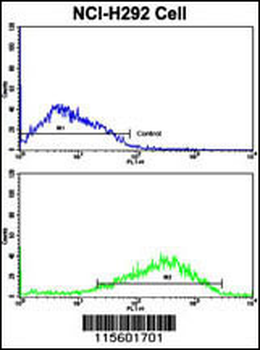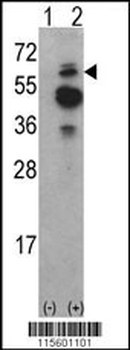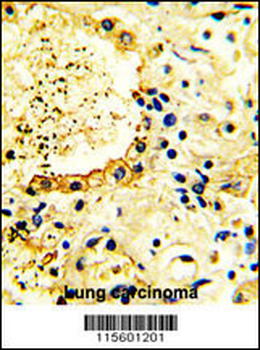You have no items in your shopping cart.
ACK1 Antibody (N-term)
Catalog Number: orb1928969
| Catalog Number | orb1928969 |
|---|---|
| Category | Antibodies |
| Description | Purified Rabbit Polyclonal Antibody (Pab) |
| Species/Host | Rabbit |
| Clonality | Polyclonal |
| Clone Number | RB15601 |
| Tested applications | FC, IHC-P, WB |
| Reactivity | Human |
| Isotype | Rabbit IgG |
| Antibody Type | Primary Antibody |
| Dilution range | WB: 1:1000, WB: 1:1000, IHC-P: 1:50~100, FC: 1:10~50 |
| Form/Appearance | Purified polyclonal antibody supplied in PBS with 0.09% (W/V) sodium azide. This antibody is prepared by Saturated Ammonium Sulfate (SAS) precipitation followed by dialysis against PBS. |
| Conjugation | Unconjugated |
| MW | 114569 Da |
| Target | This ACK1 antibody is generated from rabbits immunized with a KLH conjugated synthetic peptide between 10-39 amino acids from the N-terminal region of human ACK1. |
| UniProt ID | Q07912 |
| NCBI | NP_005772.3, NP_001010938.1 |
| Storage | Maintain refrigerated at 2-8°C for up to 2 weeks. For long term storage store at -20°C in small aliquots to prevent freeze-thaw cycles |
| Alternative names | Activated CDC42 kinase 1, ACK-1, Tyrosine kinase n Read more... |
| Note | For research use only |
| Expiration Date | 12 months from date of receipt. |

Western blot analysis of ACK1 Antibody (N-term) in K562 cell line lysates (35 ug/lane). ACK1 (arrow) was detected using the purified Pab.

Flow cytometric analysis of NCI-H292 cells using ACK1 Antibody (N-term) (bottom histogram) compared to a negative control cell (top histogram). FITC-conjugated goat-anti-rabbit secondary antibodies were used for the analysis.

Western blot analysis of ACK1 (arrow) using rabbit polyclonal ACK1 Antibody (N-term). 293 cell lysates (2 ug/lane) either nontransfected (Lane 1) or transiently transfected with the ACK1 gene (Lane 2) (60 KD recombinant protein).

Formalin-fixed and paraffin-embedded human Lung carcinoma reacted with ACK1 Antibody (N-term), which was peroxidase-conjugated to the secondary antibody, followed by DAB staining. This data demonstrates the use of this antibody for immunohistochemistry; clinical relevance has not been evaluated.


